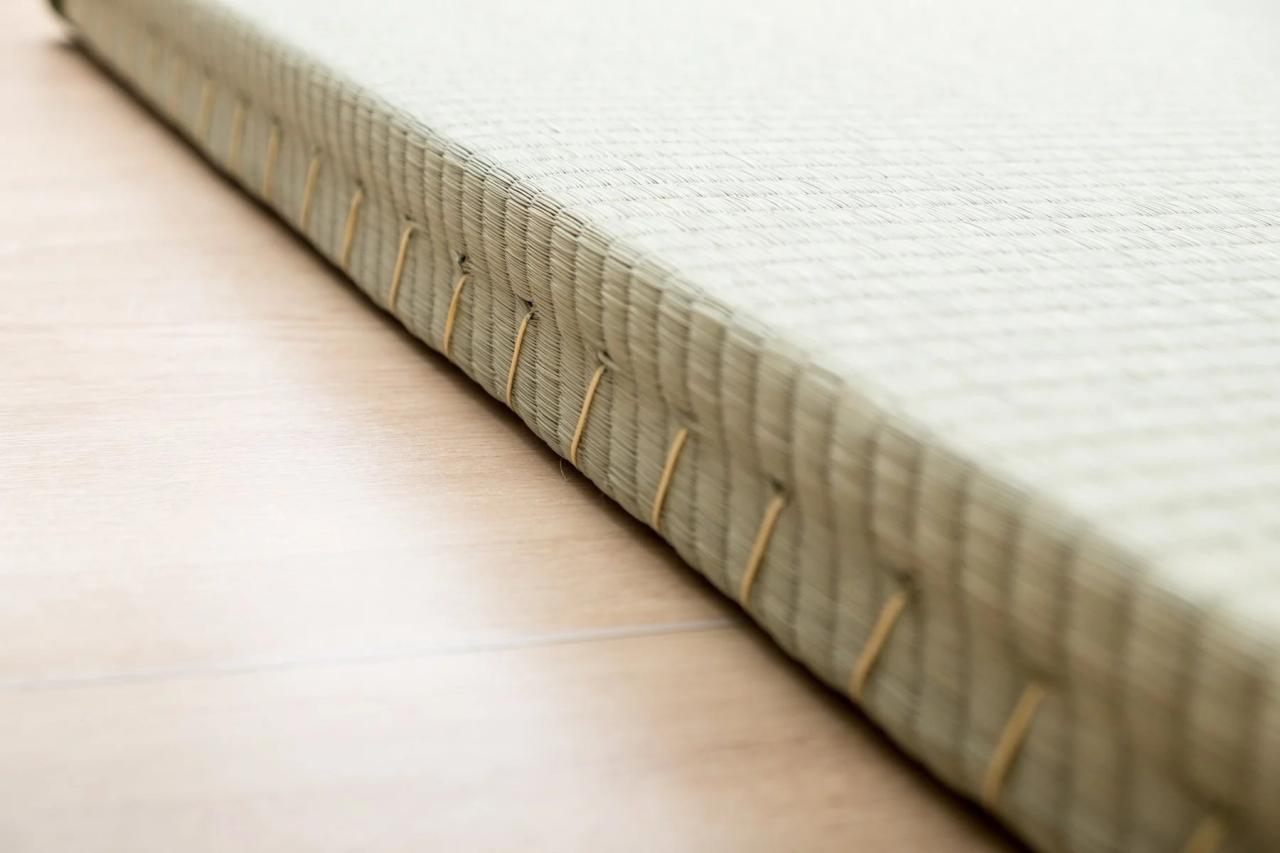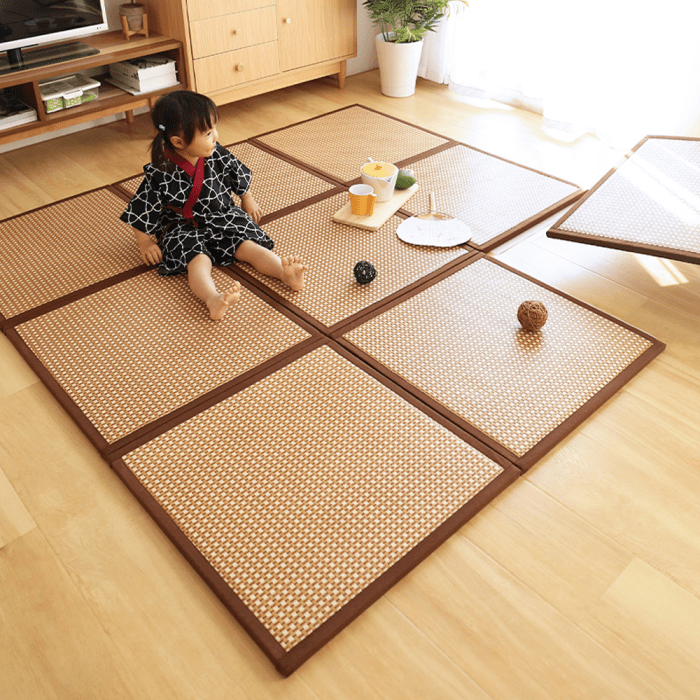Tatami mats, a staple in Japanese architecture and culture, are renowned for their unique charm and versatility. These natural fiber floor coverings have evolved over centuries, offering a comfortable and aesthetically pleasing surface for various purposes.
Crafted from rice straw or rush, tatami mats have played a significant role in Japanese homes, serving as flooring, seating, and even sleeping surfaces. Today, they continue to find applications in modern architecture and design, adding a touch of tradition and elegance to contemporary spaces.
History and Origin of Tatami Mats
Tatami mats have a rich history, deeply intertwined with Japanese culture and architecture. Their origins can be traced back to ancient Japan, where they were initially used as flooring in Buddhist temples and noble residences.
Over time, tatami mats became an integral part of traditional Japanese homes, serving both practical and aesthetic purposes. They provided a comfortable and insulating surface for sitting, sleeping, and performing various cultural activities.
Cultural Significance
In Japanese culture, tatami mats hold significant symbolic value. They represent purity, tranquility, and respect. Their size and arrangement within a room are governed by strict rules and etiquette, reflecting the Japanese emphasis on order and harmony.
In tea ceremonies, for example, tatami mats are carefully laid out to create a serene and meditative atmosphere. They also play a role in martial arts, where their firm surface provides a stable and shock-absorbent base for training.
Materials and Construction of Tatami Mats

Tatami mats are traditionally crafted using natural materials, primarily rice straw and rush grass. These fibers provide resilience, breathability, and insulation, making them ideal for flooring in traditional Japanese architecture.
Weaving and Binding
The core of a tatami mat consists of tightly packed rice straw, which is woven together using a specialized technique called tatami-ami. The weaver uses a needle to pass a rush grass cord through the straw, creating a durable and flexible weave.
Tatami mats are traditional Japanese flooring made from woven rush grass. While they are not commonly used as mattresses in modern times, they can provide a firm and supportive surface for sleeping. If you’re looking for a way to protect your tatami mat from dirt and stains, consider using a mattress protector . These covers are designed to fit snugly over your tatami mat and can be easily removed and washed as needed.
By using a mattress protector, you can help to keep your tatami mat looking its best for years to come.
The edges of the mat are then bound with a thicker rush grass cord, known as heri, which provides reinforcement and a distinctive aesthetic border.
Finishing
Once woven and bound, the tatami mat undergoes a finishing process. The surface is carefully trimmed and smoothed, and a thin layer of soft rush grass is applied to the top. This layer, called omote, provides a comfortable and non-slip surface for sitting, sleeping, or practicing martial arts.
Uses and Applications of Tatami Mats

Tatami mats have a rich history and cultural significance in Japan, traditionally serving as versatile surfaces for various purposes. In modern times, they continue to be utilized in both traditional and contemporary settings, offering unique aesthetic and functional qualities.
Traditional Uses
In traditional Japanese homes, tatami mats are primarily employed as:
- Flooring:Tatami mats cover the floors of rooms, providing a comfortable and insulating surface for walking, sitting, and sleeping.
- Seating:Tatami mats are also used as seating surfaces, with cushions or zabuton (floor cushions) placed on top for added comfort.
- Sleeping:In the absence of beds, tatami mats can be laid out side by side to create a sleeping area, providing a firm and supportive surface.
Contemporary Applications
Beyond their traditional uses, tatami mats have found innovative applications in modern architecture and design:
- Wall Coverings:Tatami mats can be installed on walls as a unique and visually appealing covering, adding texture and warmth to a space.
- Decorative Elements:Tatami mats can be incorporated into furniture pieces, such as headboards or tabletops, adding a touch of Japanese aesthetic to a contemporary setting.
- Acoustics:Tatami mats possess sound-absorbing properties, making them suitable for use in rooms where noise reduction is desired, such as music studios or offices.
Maintenance and Care of Tatami Mats
Maintaining tatami mats is crucial for extending their lifespan and preserving their aesthetic appeal. Proper care involves regular cleaning, drying, and storage techniques.
Cleaning Techniques
Regular vacuuming removes dust and debris from the surface of tatami mats. Avoid using harsh chemicals or abrasive cleaners, as these can damage the delicate surface. For spills or stains, blot with a damp cloth and avoid rubbing, which can spread the stain.
Drying Techniques, Tatami mat
Tatami mats should be dried thoroughly after cleaning to prevent mold and mildew growth. Open windows and doors to ventilate the room or use a fan to circulate air. Avoid using direct sunlight or heat sources, as these can warp or damage the mats.
Storage Techniques
When storing tatami mats, keep them in a cool, dry place with good ventilation. Stack mats vertically to allow air to circulate between them. Avoid placing heavy objects on top of the mats, as this can cause indentations or damage.
Styles and Variations of Tatami Mats
Tatami mats come in a variety of styles and variations, each with its own unique characteristics. These variations can be based on regional differences, color preferences, or specific patterns.
Regional Variations
Tatami mats are traditionally made in different regions of Japan, and each region has its own unique style. For example, Kansai-style tatami mats are known for their dark brown color and large size, while Kyushu-style tatami mats are typically lighter in color and smaller in size.
Tatami mats, with their distinct woven texture, are renowned for their versatility and comfort. While traditionally used in Japanese homes, their functionality extends beyond indoor spaces. For outdoor enthusiasts, camping mattresses offer a portable and convenient alternative to bulky air mattresses.
With similar cushioning properties to tatami mats, these specialized mattresses provide a comfortable and supportive base for restful nights under the stars. And when it’s time to pack up, they roll up compactly, echoing the space-saving nature of traditional tatami mats.
Colors
Tatami mats are typically made from natural rush grass, which gives them a natural green color. However, tatami mats can also be dyed to create different colors, such as black, brown, or red. Dyed tatami mats are often used in commercial settings, such as restaurants or hotels.
Patterns
Tatami mats can also be woven with different patterns. Some common patterns include the herringbone pattern, the diamond pattern, and the square pattern. Patterned tatami mats are often used in traditional Japanese tea rooms or other formal settings.
Factors Influencing Choice of Style
The choice of tatami mat style depends on a number of factors, including the size of the room, the purpose of the room, and personal preferences. For example, a large room may require larger tatami mats, while a small room may be better suited for smaller tatami mats.
Tatami mats are a traditional Japanese flooring material made from rice straw. They are often used in martial arts dojos and tea rooms. Tatami mats provide a comfortable and supportive surface for practicing martial arts and other activities. They are also relatively easy to clean and maintain.
If you are looking for a durable and versatile flooring option, tatami mats are a great choice.
The purpose of the room can also influence the choice of style, with more formal settings often using patterned tatami mats. Ultimately, the choice of tatami mat style is a matter of personal preference.
Concluding Remarks

Tatami mats, with their rich history, natural materials, and diverse applications, remain a timeless element in Japanese culture. Whether used in traditional settings or incorporated into modern designs, these floor coverings continue to captivate with their beauty, comfort, and versatility.
FAQ Compilation
What are tatami mats made of?
Tatami mats are traditionally made from rice straw or rush, which are natural fibers that provide comfort and durability.
How are tatami mats used?
Traditionally, tatami mats were used as flooring, seating, and sleeping surfaces in Japanese homes. Today, they are also used in modern architecture and design as wall coverings and decorative elements.
How do I care for tatami mats?
Regular cleaning and maintenance are essential to extend the lifespan of tatami mats. Vacuuming or brushing, drying in the shade, and storing in a well-ventilated area are recommended.